How to choose a coffee grinder that will maximise flavour

Table of Contents
Why you need a coffee grinder
Tip #1: Never buy pre-ground coffee
Stored airtight at room temperature, whole bean coffee loses 90% of its aroma 3-4 weeks after roasting, while ground coffee loses 90% within one day.
The aromas do not degrade at the same rate. The first aromas to go are the sweet, fruity notes, and the last ones are the malty, roasty, nutty notes—which is why much pre-ground coffee tastes the same, uniformly lifeless.
The wonderful, magical, diverse, complex fruit tastes and smells you see in the Coffee Tasters Wheel can’t be experienced unless you use fresh, well-stored coffee, ground with a good grinder just before brewing it.
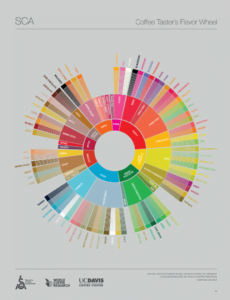
A lot of people say, “All coffee tastes the same to me,” “My taste buds are not that refined to notice the difference,” “ Coffee nerds have pure imagination,” or “Marketing BS, it never tastes like that to me.”
Many have never tasted good specialty coffee with optimum freshness, uniform ground, and well extraction. That is sad. Life is too short to drink bad coffee.
Tip #2 a coffee grinder enables changing the grind size
Another reason for grinding yourself is the ability to control the grind size. You need different grind sizes for various extraction methods:
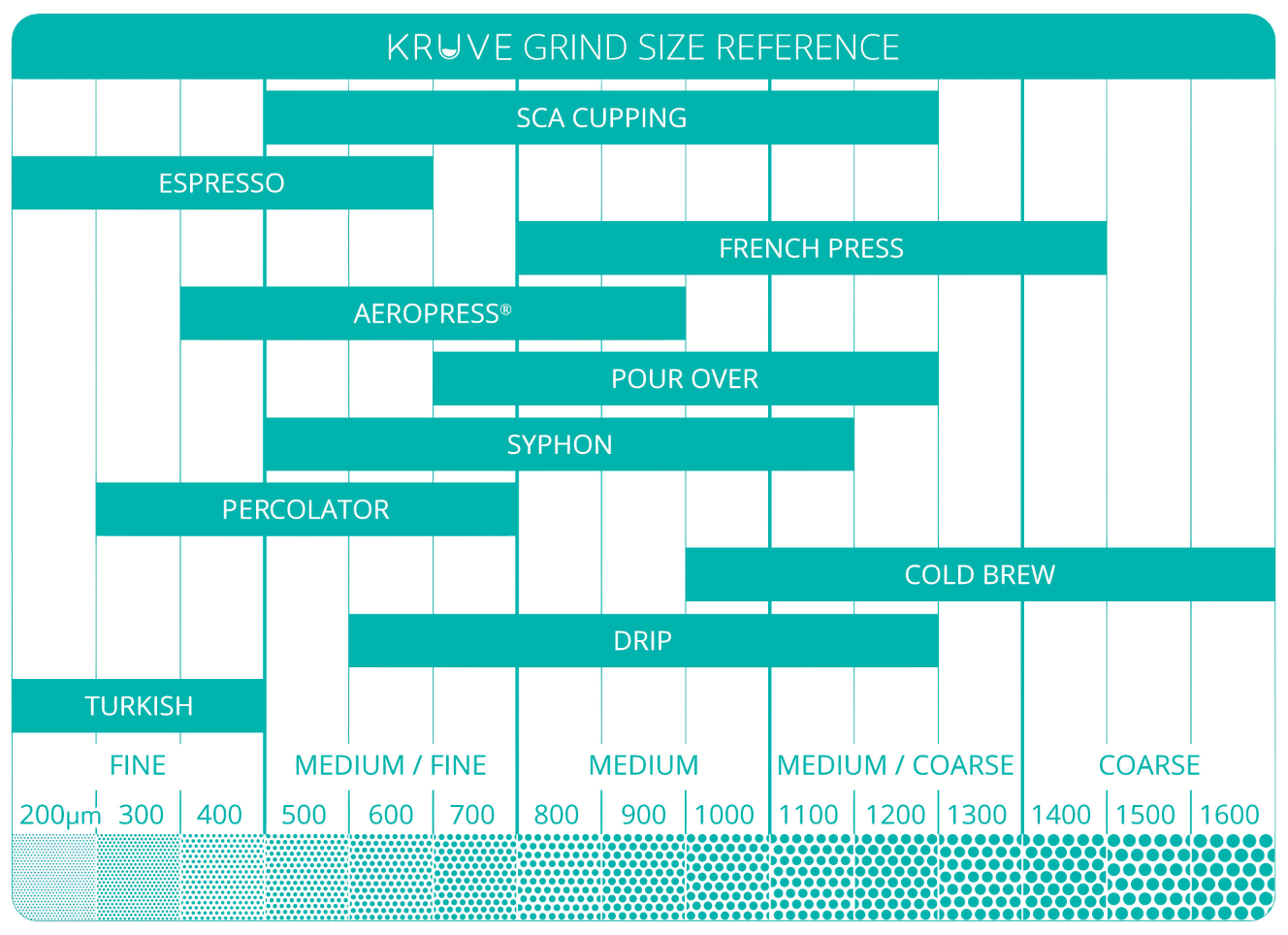
Different grind sizes are also required for Roast Levels to help control how much you extract. Dark roasts weaken the bean cell structure, making it brittle, porous, and much more soluble. Grinding coarser helps avoid bitter over-extraction. Light roasts leave the bean cell structure very hard and not very soluble at all. Grinding finer helps avoid sourness from under-extraction.
Grind size is also used to control water-to-coffee contact time. You can slow an extraction down in an espresso puck by grinding finer or speed it up by grinding coarser. The same thing applies to drip filter coffee, such as a v60 or Hario Switch, controlling the draw-down contact time.
You can achieve great coffee and do it better than most cafés. Cafes tend to serve a generic blend for high-volume consistency and have to bang out a lot of coffee quickly. Home enthusiasts do not have these limitations; you can use the best coffee, get your hands on it, and take all the time, care, and attention to try and create exquisite coffee.
But you do need one thing: a good grinder, preferably the best grinder you can find.
When I first started in coffee, I thought it ridiculous to claim you could taste a grinder. I know people who have only ever used a blade grinder with a French Press or a Mokka Pot. But now, having used a range of grinders, I’ve happily spent 5x more on my grinder than on my espresso machine. The grinder is the most critical piece of equipment.
The most important thing the grinder needs to achieve is the best grind uniformity possible.
Tip #3 Burr alignment, avoid plastic
One incident really brought it home to me how the grinder affects the flavour.
At home, I have what is widely considered to be one of the world’s best coffee grinders, the KafaTek Monolith Flat MAX (98mm Shuriken Light/Medium flat burrs, low speed 400 rpm, step-less adjustments, hopper-less single dosing, zero retention, bellows, extraordinary build quality, all metal with the highest tolerances, exceptional burr alignment).
One time, I had an amazing Indian coffee from Balmaadi Estate. It had beautiful sparkling strawberry and tobacco notes (Natural Process, Kent, S795). I was enthusiastically regaling an Indian friend at work how great it was, and he really wanted to try it.
Now, I had a coffee grinder at work, a Fellow Ode. Certainly nowhere near as expensive a grinder as the KafaTek, but still a flat burr (64mm, 1400rpm, stepped, plastic parts).
The Balmaadi ground with the Fellow Ode tasted of flat, damp earth and hessian. Nothing I tried could reveal the beauty I knew that coffee was capable of.
I upgraded the burr set in the Fellow Ode to SSP Red Speed Coated 64mm Flat Brew Burrs, but it didn’t fix the problem. It was obvious when I measured the grinds with a Kruve Brewler, that the Fellow Ode grinder did not have the high engineering tight tolerances required for perfect burr alignment.
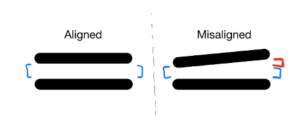
I eventually replaced the Fellow Ode with a much more expensive and well-engineered Option-O Lagom P64 with 64mm SSP Unimodal Espresso/Multipurpose flat burrs.
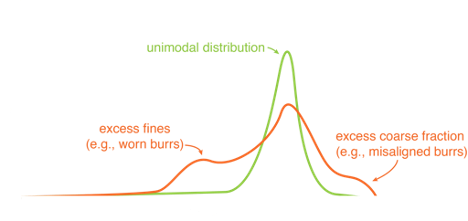
What’s happening?
During coffee extraction, large particles, known as boulders, don’t saturate, under-extract, and produce sourness.
Small particles, known as fines, under 100 microns, over-extract, producing bitterness. The greater the variety of particle sizes, the more the cup’s noise obscures the flavours.
Grind uniformity is the key to revealing flavours in great coffee.
The cheaper grinders have plastic parts that can’t achieve perfect burr alignment and tight tolerances. It is well worth buying a CNC-machined metal grinder (such as Option-O) over a plastic one. Burr alignment is the most important aspect, so I would not purchase a plastic grinder, and that includes Niche Zero, Fellow Ode etc. (Lance Hedrick 1 year with niche, https://ag4tech.com/niche-zero-review/)
While going from a blade grinder to any burr grinder is going to be a massive improvement, going from progressively more expensive burr grinders does not match the law of diminishing returns.
The flavour Separation you can achieve with a perfectly aligned burr is miles ahead of misaligned burrs. If your burrs are misaligned, it doesn’t matter how good the burrs are. Instead of the law of diminishing returns, it is the law of increasing returns.
This is why investing in a grinder capable of the best burr alignment possible is a very worthwhile investment if you want to explore the variety of coffee flavours. It is also why an extraordinary hand grinder like the Kinu M47 Classic can outperform many electronic burr grinders that cost a lot more.
What to look for. CNC-milled 10-micron tolerances. If you see plastic parts, it can’t be good.
However, a cheap all-metal grinder might not be very good. It is difficult and expensive to achieve that level of precision.
James Hoffman df64 gen 1 review
- Small espresso adjustment range
- Holder forks poor
- Rudimentary declumping screen causes retention
- Regrinding muddy harshness
- 1400 rpm high static
- Access to the burrs difficult
- The design doesn’t clear the grinds chamber adequately, and the bellows are not enough.
Note these issues have been largely addressed in gen 2.
Tip #4 Don’t use a blade grinder
Blade grinders just smash the beans up. There is virtually no grind uniformity.
They produce a lot of fines. A particle distribution curve will look like this…
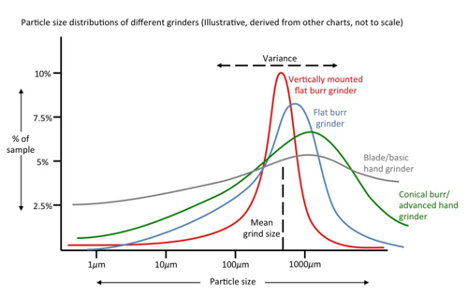
If you are using a blade grinder, do yourself a massive favour and get a burr grinder.
Incidentally, Sifting doesn’t get rid of all the small particles. Millions of them are still stuck to the larger grinds. When coffee is torn apart in the grinder, pockets of positive and negative charges all over the grinds attract the fines. Conclusion: Sifting is pretty useless for particle segregation and testing.
Tip #6 Use RDT
Static electricity is a much bigger problem than most people give credit for. Coffee beans are very dry, with very little moisture. A 1400 rpm grinder creates a massive amount of friction. Every grinder produces fines, even the most expensive grinder with low-speed big flat burrs.
The fines are microscopic, so they can’t be seen with the naked eye. There are millions of them, and static electricity makes them stick to all the grinds. If you see clumps, or coffee sticking to the exit chute, you need more RDT.
RDT, Ross Droplet Technique is spraying the beans with water before grinding and is highly recommended. This is far more effective than deionisers, anti-clumpers, and WDT Tools. RDT not only reduces the static, it improves the flavour.
RDT will likely increase retention in the grinder, and you can even get wet whole beans sticking to a wall. Being able to open the grinder and brush the walls and burrs before and after every grind is a big help. Easy access to the burrs is another design feature to look for.
Tip #7 The best grinders are large flat burrs
There are two types of burr grinders, Conical and Flats.
Conical burs, one sits inside the other like a cup. The beans are gravity fed, and the gap between the burrs is the widest at the top to let the beans in and the smallest at the bottom for the final grind size. The grinding action is bimodal; the beans are first shattered at the top, producing more fines. Then, the Beans are ground to the size that will exit. A particle distribution curve of a conical grinder shows a double hump.
Flat burrs sets have two disks that lie “flat” against each other and are often horizontally aligned with angled teeth. These are Centrifugal fed. A particle distribution curve typically shows a more Unimodal single peak than a Conical. However, this is not to say all flat burr grinders are better than conical. Burr alignment is of primary importance so that a cheap flat will be outperformed by an excellent conical.
Flat burrs first came to the fore in 2014 when Matt Perger opted to use a Mahlkoenig EK43 at the World Barista Championship. Since then, their popularity has risen, particularly among espresso enthusiasts.
Mahlkoenig marketing states
“The EK43 has conquered the international coffee specialty industry and rules as the undisputed queen of coffee grinders”.
Opinions do differ on the EK43. It was designed as a spice grinder, with 1750 rpm and a large Hopper. In James Hoffman’s test of top-end grinders, it came last and was beaten by the much smaller, cheaper Option-O P64.
Flat Burr grinders are generally more expensive, and most domestic grinders are only conical. However, the grinder market is rapidly evolving; there are now economical flat grinders:
DF54 review: They just disrupted the grinder market
The bigger the burrs are, the more cutting surfaces, the greater the throughput generating the least friction and static electricity. But don’t forget burr alignment. Smaller burrs with better tolerances will outperform a cheap big burr grinder. Bigger is not necessarily better.
When it comes to flat burr grinders and retention, an angled grinder is better than a vertical grinder. The tilt helps gravity dislodge the grinds.
Due to static electricity, grinds will build up in the exit chute. Some grinders provide knockers, but I prefer the magnetic removable exit chute on the KafaTek Monolith Flat MAX.
Tip #8 Use steel burrs, not ceramic
Ceramic burrs are moulded and not as sharp or as uniform as steel burrs. They are also not as durable and can be chipped by foreign materials, such as a tiny stone in with the beans, which can happen. Some people maintain they are suitable for reducing heat. You want as little heat as possible because heat burns the oils in beans, which negatively impacts flavour by “cooking” the beans during grinding. But in low-volume domestic grinding, heat isn’t such a consideration.
Some people maintain ceramic burr grinders have a distinct mouthfeel and more body compared to stainless steel burr grinders. Mouthfeel and increased body are caused by producing more bitter fines that obscure flavours. These terms should raise a red flag when you see them. Ceramic burrs are more akin to blade grinders and are best avoided.
Tip #9 What are SSP burrs?
Sung Sim Precision, more commonly known as SSP, is a brand from South Korea that specialises in making high-quality aftermarket burrs.
Choosing a grinder that can upgrade the burrs is worthwhile.
Tip #10 Slow speed is better
High speed is not good. It produces more friction, static, and fines. 400 rpm will produce better-tasting coffee than 1500 rpm.
A motor needs to be powerful so it does not stall on light roasts at slow speeds. Even the Weber EG1 suffers from stalling. You can feed it slowly to help reduce stalling.
Tip #11 Avoid hoppers, single dose
Coffee is degraded by oxygen temperature, moisture, and staling. Therefore, commercial grinders’ coffee storage and grinder requirements in high-volume cafes differ significantly from those of low-volume domestic grinders at home.
Busy coffee shops get through kilos of coffee in a day. Sealed 3kg bags come from a roaster and are used within days. When opened and poured into the Hopper, the coffee will be all ground and used within hours. The coffee does not have a long time sitting around from roasting and is not in the open long. The weight of the coffee in the Hopper helps feed the grinder. Retention of grinds is much less of an issue because there is little time for the coffee to stale in the grinder.
Loss of volatile aroma compounds and oxidation forms new aroma compounds that impart off flavours.
The quickest way to ruin your coffee at home is to store it in a Hopper.
There is a 50% decrease in shelf life for each 10c increase in temperature.
The only way to slow staling is to freeze. Freezing slows kinetic reactions.
Store in single doses for maximum freshness and freeze your coffee as soon as possible.
An excellent domestic grinder will not have a Hopper; it will be designed for grinding a single dose, without the weight of beans in a Hopper, so it will have an anti-popcorning device to stop the beans from bouncing out.
The grinder has to be designed for single dosing.
The Eurekas are traditional flat burr grinders, not suitable for single dosing. I’ve used several Mignons and one of their 64mm grinders, and they become mediocre to poor when the hopper is not full enough. This becomes especially apparent for finer grinds when the grinders slow down, and the grinds become inconsistent. This is on the same grinders that will happily churn out Turkish powder if you fill the hopper.
The Niche is designed for single dosing and is highly consistent.
Tip #12 Zero retention
The grinder needs to be designed for zero retention. Bellows are helpful to ensure there is not yesterday’s stale coffee in the grinder, and you don’t need to waste beans purging. An angled flat burr grinder usually has less retention than a vertical.
Top domestic grinders are a speciality feature-wise. It would be best to have Single Dosing, not a Hopper full of beans like coffee shops. Designing for perfect burr alignment, single dosing, anti-popcorning, and zero retention is difficult.
Tip #13 grinder journey
Most people don’t realise how much their grinder is holding them back.
Many people go on a grinder journey, starting with a cheap grinder and then doing a series of upgrades, wondering what the top grinders could do for them.
So here is my grinder journey and what I found out on the way.
I wanted to start with a cheap but allegedly reasonably good grinder to see if I could make decent coffee myself that I would be happy with and if home coffee was worth investing in.
You can get a better hand grinder for the same price as an electric one, and you’ll have something to take on holiday.
Tip #14 Stepless is better
So, my first grinder was the well-regarded 1zpresso Jx Pro.
I could make good coffee with it, so it passed that test. But I had two issues with it. First, the problem with all hand grinders is that you get sick of putting the effort in, plus light roasts can be a real pain. You are going to want an electric grinder at some point. The second issue was that the 1zpresso is a stepped grinder, and for espresso on my Flair Pro2, I needed to be in between steps quite often. Being stepped was frustrating.
I was determined to get the best electric grinder on the planet. But you cannot just walk into a shop and buy it or even order it online. It took me two years to get my KafaTek.
I wanted a better hand grinder to tide me over and keep in perpetuity for travel.
So I bought the Kinu M47 Classic—an excellent step-less conical burr hand grinder built like a tank. I also got the optional silicon band that helps considerably when grinding light roasts. The factory set at zero was perfect. I’ve had it for years, and it is perfect. I have no need or desire to upgrade it.
The Commandante is another hand grinder many people go for, but that is stepped. You can get red speed half clicks, but I still would not do it myself. Counting clicks is tedious.
My end game grinder came down to a choice between the KafaTek Monolith Flat Max or the Weber EG1. The EG1 may be better looking, but it has smaller burrs, fewer burr choices, and an underpowered motor that can stall on light roasts. The KafaTek has been excellent.
For a grinder at work, as covered above, I regretfully started with the Fellow Ode, tried upgrading to SSP burrs, and then replaced the grinder with the Option-O P64.
Features that I much prefer on the KafaTek over the Option-O P64 are a much bigger adjustment wheel, more accessible to brush the burr chamber, a removable magnetic funnel, faster grinding, and better taste. Note that Option-O now have the more extensive Option 01 and P100 models.
Tip #15 Use great Coffee
You can’t make a silk purse out of a sow’s ear. Get yourself a lovely specialty coffee, a good variety of Colombian Caturra or Ethiopian Landraces, from a good producer. It will outperform your generic blended coffee.
To help you find good coffee, read https://density.coffee/best-coffee-beans/
Tip #16 Freeze your coffee beans
Once you have good coffee, keep it good
Coffee Grinder recommendations
Electric Grinders:
- If you are starting out and want something cheap but good
MiiCoffee DF54 Single Dose Coffee Grinder
DF54 review: They just disrupted the grinder market
- If you want something very good and are prepared to pay: Option-o Lagom P64
- If you just want the best and money is no object KafaTek Monolith Flat Max
James Hoffman Kafatek Monolith Flat Max review
Hand Grinders
- If you are starting out and want something cheap but good 1zpresso
- If you just want the best Kinu M47 Classic